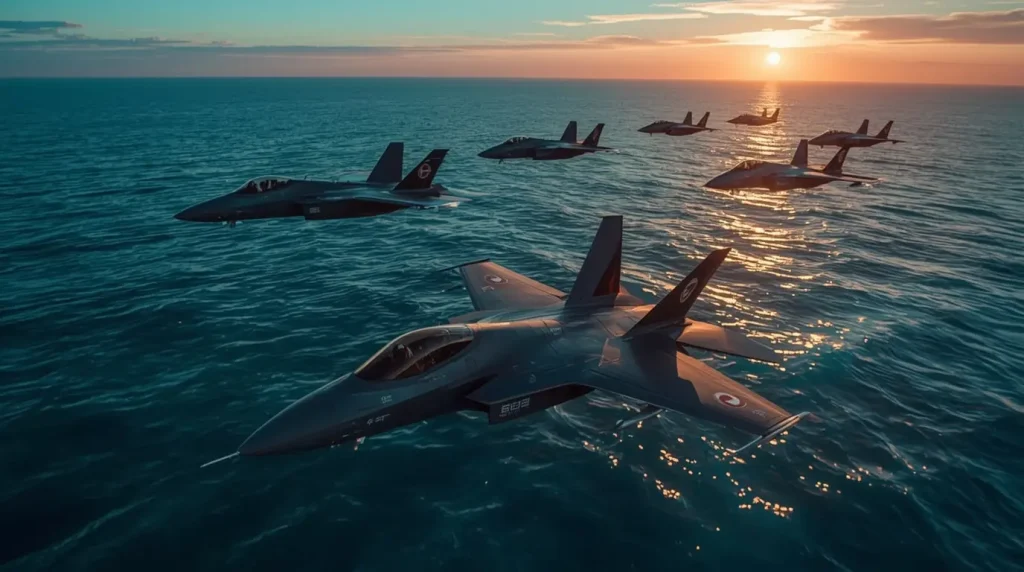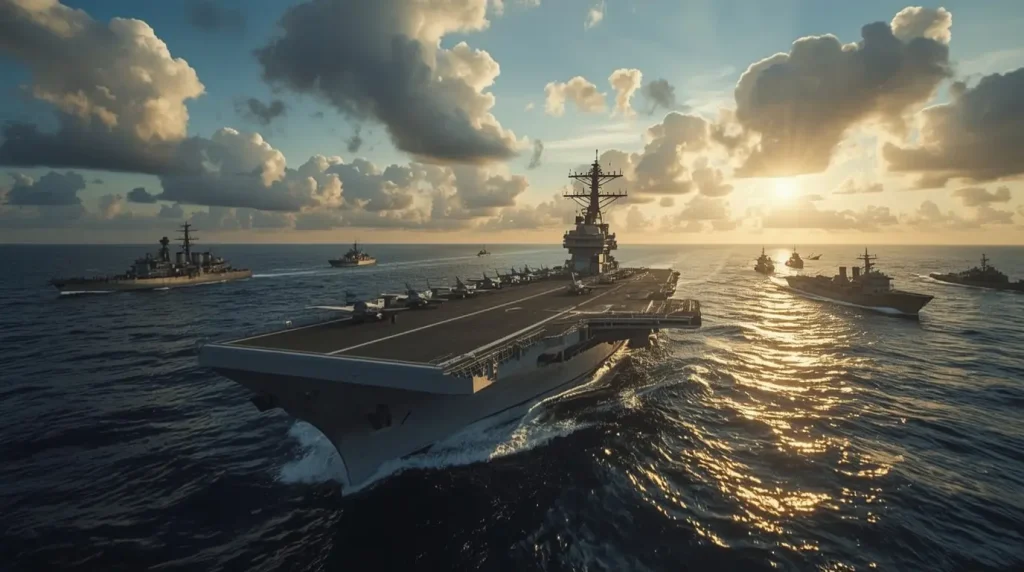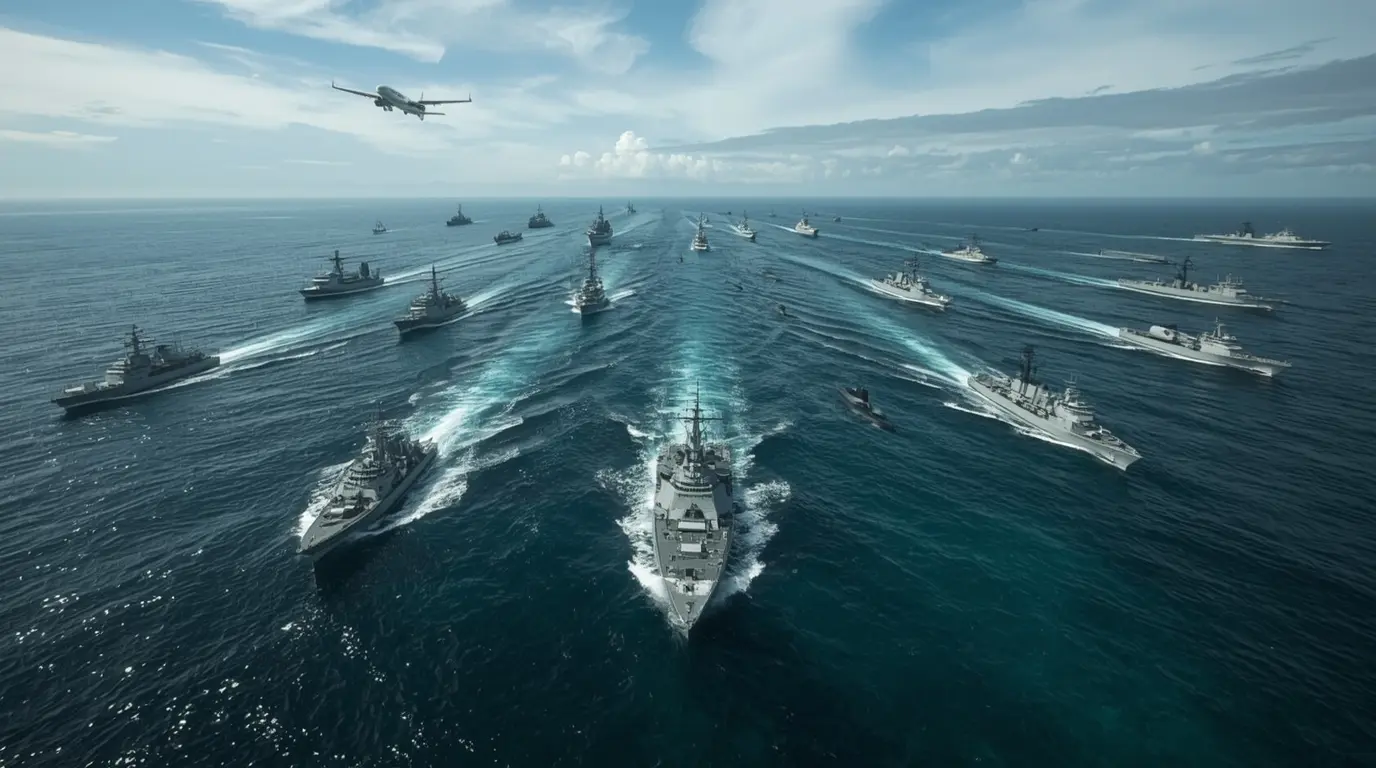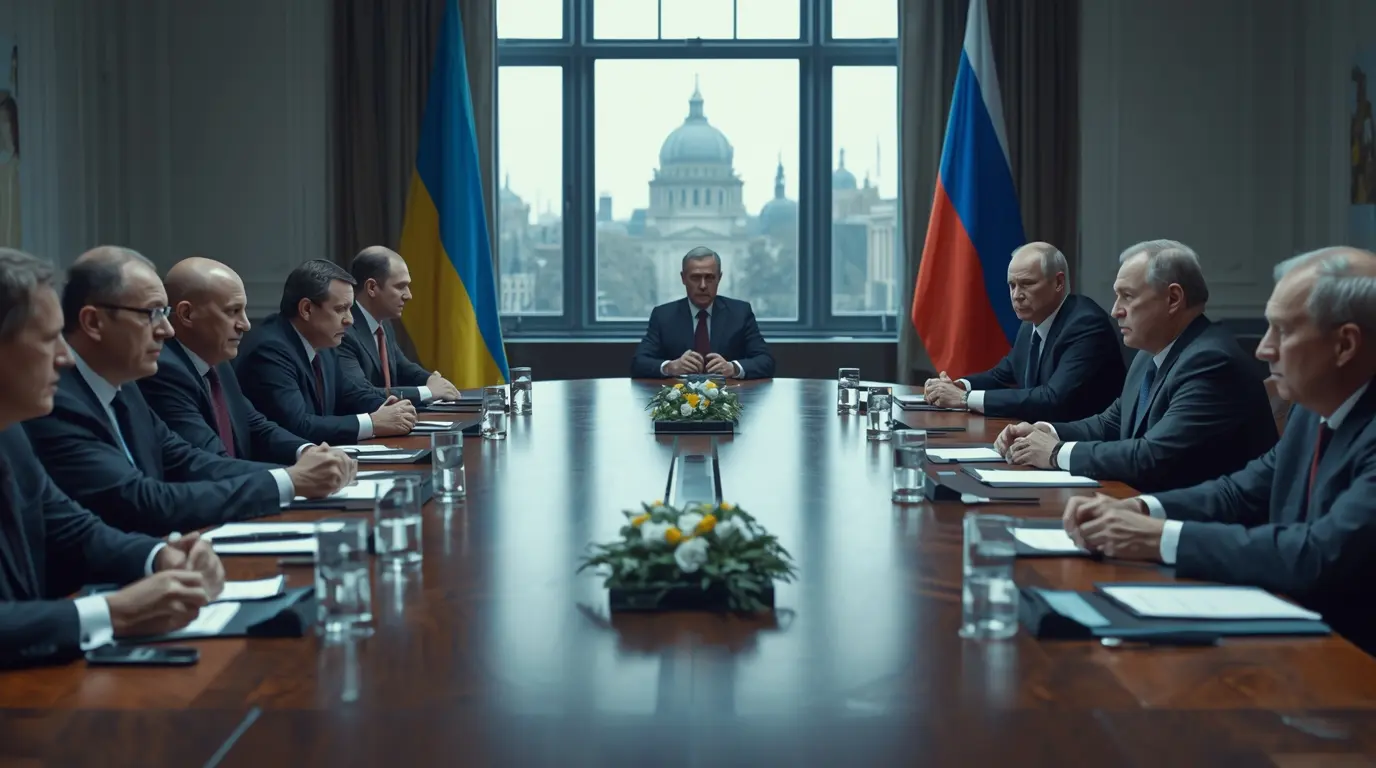Pacific military exercises have settled into a key role in regional security planning as the United States and its partners carry out synchronized drills across the Indo-Pacific. These exercises reflect a united pledge to maintain order in the waters and skies amid rising worries over Chinese maritime and air activities. The latest round of drills features unprecedented collaboration across several countries, proving their readiness to address multifaceted challenges as a cohesive force. This piece will examine why these drills matter, what their scale looks like, and how they are influencing the Indo-Pacific’s future geopolitics.
The Strategic Context of Recent Pacific Military Drills
Shifts in the Pacific security environment have become, in the words of military officials, “increasingly severe,” thereby accelerating the push for heightened defensive exercises. Recently, a force of over twenty aircraft—representing the United States, Japan, and the United Kingdom—carried out coordinated tactical air maneuvers to the east of Okinawa, Japan, in a clear extension of ongoing Pacific drills. These actions are a decisive message that the partner nations will “not tolerate unilateral changes to the status quo by force.”
Recently, the Department of Defense wrapped up large-scale military exercises in the Indo-Pacific, focusing on the skills needed to counter possible aggression. A key part of the effort, dubbed REFORPAC 2025, showed how quickly the U.S. Air Force can move and operate aircraft across the region, training side-by-side with allies, especially Japan. These Pacific military drills help ensure forces are ready for different situations while also helping troops from partner nations work together smoothly.
Key Exercises in the Pacific Military Drills Program

Trilateral Air Exercises
One of the biggest segments of the Pacific exercises was the trilateral air operation that brought together 26 aircraft from the United States, Japan, and the United Kingdom. Here’s what each country contributed:
- United States:
- F-35A Lightning II stealth fighters
- F-15E Strike Eagle fighters
- E-3 Sentry Airborne Early Warning and Control aircraft (AWACS)
- KC-135 Stratotanker aerial refuelers
- RC-135 Rivet Joint reconnaissance planes
- EA-18G Growler electronic attack jets
- Japan:
- F-15 Eagle fighters from the Japan Air Self-Defense Force
- United Kingdom:
- Seven F-35B stealth fighters flying from the U.K. Carrier Strike Group and stationed on the HMS Prince of Wales aircraft carrier.
This mix of platforms and nations shows how the drills have a wide scope and help ensure that allies can work together seamlessly in the Pacific.
Large-Scale Joint Exercises
REFORPAC 2025 was one of the biggest training events the Pacific has ever seen. Roughly 400 U.S. and partner aircraft simultaneously operated across more than 50 sites—spread over 3,000 miles—demonstrating the region’s ability to deploy and sustain airpower. The operation served as a proving ground for the Air Force’s Agile Combat Employment (ACE) concept, a core piece of the U.S. strategy. In ACE, aircraft launch from dispersed and sometimes temporary “pop-up airbases” to keep the enemy guessing and to protect vital assets. The drills showed how quickly forces can be moved and refueled, which is key to a successful defense.
While REFORPAC was winding down, U.S. forces shifted to Talisman Sabre in Australia. This three-week joint and combined exercise gathered 40,000 personnel from 19 nations, including U.S. and UK aircraft carriers. The drills included firing long-range missiles, conducting amphibious beach landings, and rapidly moving ground and aviation forces to forward positions. Altogether, these Pacific military drills tested how well allied forces can integrate air, land, and sea assets in a crisis, while giving commanders valuable lessons in command and control across vast distances.

Table: Major Recent Pacific Military Drills
| Exercise Name | Participating Nations | Key Assets | Primary Focus |
|---|---|---|---|
| REFORPAC 2025 | U.S., Japan, and coalition partners | 400+ aircraft, 50+ locations | Aircraft surge, Agile Combat Employment |
| Talisman Sabre | 19 nations including U.S., Australia, UK | 40,000 troops, multiple carriers | Long-range fires, amphibious operations |
| Trilateral Air Exercises | U.S., Japan, UK | 26 aircraft including F-35s | Air superiority, coordinated tactics |
Military Capabilities and Strategies in Pacific Military Drills
The Pacific drills are showing us how today’s military focuses on the security problems that keep surfacing in the region. During the exercises, forces worked on Agile Combat Employment, a plan that helps U.S. planes stay in the fight and survive if conflict breaks out near the Pacific. This idea works well in protecting aircraft, but the supply and logistics that support it are still pretty tricky to figure out.
These exercises also spotlight today’s technology. We saw fifth-generation F-35 Lightning II jets joining the flights. Their ability to slip in unseen, combined with super-high-tech sensors, lets commanders piece the battlefield picture together faster. Along with the stealth Fighters, we had the EA-18G Growler out front. This electronic attack craft shows that silence the enemy’s radar and communication is now just as key as firing slick missiles or dropping bombs in the fight.
Talisman Sabre Showcases New Weapons
Talisman Sabre 2023 stood out for showing off new military tech. For the first time, Australia fired the Precision Strike Missile (PrSM) in a live exercise, while the U.S. Army’s 3rd Multi-Domain Task Force tested its Typhon Mid-Range Capability’s (MRC) missile against a moving ship—also a first for Australia. These tests prove that big naval drills in the Pacific are now trial runs for the latest weapon ideas.
Allied Integration Takes Center Stage in the Pacific
Operating in the Pacific has become so complicated that simply referring to “countries in the Pacific” no longer captures the picture. This time, the U.K. joined the exercise to reinforce the concept of “Allied Integration.” The U.K. Carrier Strike Group was out in force, led by the aircraft carrier Prince of Wales. The group also included destroyer HMS Dauntless, frigate HMS Richmond, a Norwegian frigate—HNoMS Roald Amundsen—and the fleet oiler RFA Tidespring. Their participation illustrates a deliberate and growing pledge by international partners to step up their presence and cooperation in keeping peace in the Pacific.
Japan is stepping into a bigger spotlight during this year’s Pacific military exercises. The Japan Maritime Self-Defense Force destroyer JS Akebono has joined the UK Carrier Strike Group as the task group leaves Tokyo. The ship will stick with the group all the way into the Indian Ocean. Before that, the UK group and Japan’s air-defence force held drills in the Sea of Japan. Four F-35A and eight F-15 fighters from the Japan Air Self-Defense Force stood in on the run with four F-35B jets from the Prince of Wales.
The skills sharpened during all these Pacific drills are raising the bar on deterrence. The analysts put it this way: “As China and Russia boost their cooperation, events like REFORPAC and Talisman Sabre show how vital it is to train with allies and partners.”
Regional Implications of Pacific Military Drills
Pacific military drills are ramping up, and they come just as tensions in the region are getting higher. Beijing has intensified large-scale military maneuvers around Taiwan, acting as if preparing for possible aggression against the island. China isn’t acting alone; it is tightening cooperation with Russia. The recent “Joint Sea 2025” exercise in the Sea of Japan included anti-submarine drills and simulated strikes, sending a clear signal about the strategic partnership in the region.
Because of these developments, allied military drills in the Pacific are more than routine; they are a vital part of regional security. The exercises stretch across a wide operational space, highlighting why it’s crucial for allied forces to remain forward deployed. If Beijing concludes that it can achieve its objectives before reinforcements can arrive, the risk of miscalculation grows. Ongoing drills show that U.S. and allied forces can be surged into the region quickly and that they can sustain operations if a crisis escalates.
These drills are not just about numbers; they are a platform for each military service to refine capabilities that challenge possible adversaries. For instance, the Army is developing long-range maritime strike platforms that extend attack options well beyond shore, while the Air Force employs Agile Combat Employment (ACE) concepts to enhance rapid response across the theater. Together, these initiatives create choices and dilemmas for any potential opponent, further reinforcing deterrence in the Pacific.
Future Outlook for Pacific Military Exercises
Over the next few years, Pacific military drills are expected to be bigger and happen more often. Defense leaders keep stressing that exercises like REFORPAC and Talisman Sabre have to run on a tight schedule if the U.S. is to bulk up its force posture in the Pacific and keep it supplied during a crisis. Officials are also pointing to a need for a bigger role for partner nations in these missions.
Bringing in more international forces may not just be good for practice; it may be the best public signal for Pacific security as well. Analysts covering recent drills summed up the benefit: “Having regional players, Taiwan among them, step in during sessions allows them to practice interlinking and showing that linkage with the United States and allied militaries.”
On the tech side, Pacific exercises will head for the next level by combining more data from cyber units, space programs, and artificial intelligence. Giving these systems a starring role in scenarios will keep drills valuable and up-to-date with the kinds of challenges that keep military planners awake at night.
Conclusion
The continuing series of Pacific military exercises serves as a backbone of regional security, affirming our allies’ determination and readiness in a climate of growing challenges. These operations boost how well different forces work together, trial cutting-edge concepts and technologies, and project a clear commitment to upholding a stable, rules-based international environment. As security conditions shift, the Pacific exercises will gain even greater weight as a pillar of both deterrence and day-to-day readiness.
The teamwork that recent exercises have showcased—from the trilateral air operations around Okinawa to the broad REFORPAC 2025 and Talisman Sabre drills—confirms that allies and partners are resolved to confront shared security challenges in unison. One recent note put it well, highlighting the significance of “forward-deployed U.S. forces operating with allies and partners.” Looking ahead, Pacific military drills will remain a crucial linchpin of peace and stability across the wider Indo-Pacific for the foreseeable horizon.
Source: https://edition.cnn.com/2025/09/16/asia/us-japan-south-korea-exercises-analysis-intl-hnk-ml
For more incredible stories of everyday news, return to our homepage.





